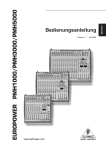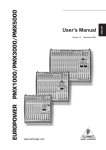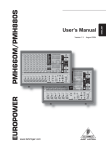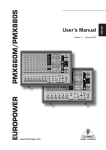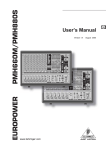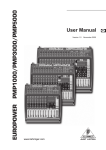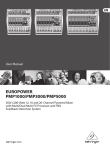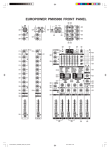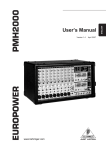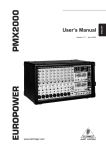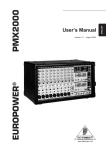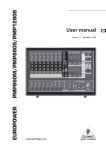Download Behringer PMX5000 User`s manual
Transcript
EUROPOWER PMH1000/PMH3000/PMH5000 Version 1.2 November 2004 ENGLISH User’s Manual EUROPOWER PMH1000/PMH3000/PMH5000 IMPORTANT SAFETY INSTRUCTIONS DETAILED SAFETY INSTRUCTIONS: 1) Read these instructions. 2) Keep these instructions. 3) Heed all warnings. 4) Follow all instructions. CAUTION: WARNING: To reduce the risk of electric shock, do not remove the top cover (or the rear section). No user serviceable parts inside; refer servicing to qualified personnel. To reduce the risk of fire or electric shock, do not expose this appliance to rain and moisture. The apparatus shall not be exposed to dripping or splashing and no objects filled with liquids, such as vases, shall be placed on the apparatus. This symbol, wherever it appears, alerts you to the presence of uninsulated dangerous voltage inside the enclosure—voltage that may be sufficient to constitute a risk of shock. 5) Do not use this apparatus near water. 6) Clean only with dry cloth. 7) Do not block any ventilation openings. Install in accordance with the manufacturer’s instructions. 8) Do not install near any heat sources such as radiators, heat registers, stoves, or other apparatus (including amplifiers) that produce heat. 9) Do not defeat the safety purpose of the polarized or grounding-type plug. A polarized plug has two blades with one wider than the other. A grounding type plug has two blades and a third grounding prong. The wide blade or the third prong are provided for your safety. If the provided plug does not fit into your outlet, consult an electrician for replacement of the obsolete outlet. 10) Protect the power cord from being walked on or pinched particularly at plugs, convenience receptacles, and the point where they exit from the apparatus. This symbol, wherever it appears, alerts you to important operating and maintenance instructions in the accompanying literature. Please read the manual. 11) Only use attachments/accessories specified by the manufacturer. 12) Use only with the cart, stand, tripod, bracket, or table specified by the manufacturer, or sold with the apparatus. When a cart is used, use caution when moving the cart/apparatus combination to avoid injury from tip-over. 13) Unplug this apparatus during lightning storms or when unused for long periods of time. 14) Refer all servicing to qualified service personnel. Servicing is required when the apparatus has been damaged in any way, such as power supply cord or plug is damaged, liquid has been spilled or objects have fallen into the apparatus, the apparatus has been exposed to rain or moisture, does not operate normally, or has been dropped. 15) CAUTION - These service instructions are for use by qualified service personnel only. To reduce the risk of electric shock do not perform any servicing other than that contained in the operation instructions unless you are qualified to do so. 2 EUROPOWER PMH1000/PMH3000/PMH5000 FOREWORD Dear Customer, Welcome to the team of EUROPOWER users and thank you very much for expressing your confidence in BEHRINGER products by purchasing this power mixer. It is one of my most pleasant tasks to write this letter to you, because it is the culmination of many months of hard work delivered by our engineering team to reach a very ambitious goal: to present you three outstanding power mixers that give you maximum flexibility and performance with a unique sound character and broad range of striking functions. The task to design the new PMH series certainly meant a great deal of responsibility, which we assumed by focusing on you, the discerning user and musician. It also meant a lot of work and night shifts to accomplish this goal. But it was fun, too. Developing a product usually brings a lot of people together, and what a great feeling it is when everybody who participated in such a project can be proud of what we’ve achieved. It is our philosophy to share our joy with you, because you are the most important member of the BEHRINGER team. With your highly competent suggestions for new products you’ve greatly contributed to shaping our company and making it successful. In return, we guarantee you uncompromising quality as well as excellent technical and audio properties at an extremely favorable price. All of this will enable you to fully unfold your creativity without being hampered by budget constraints. TABLE OF CONTENTS 1. INTRODUCTION ......................................................... 4 1.1 Before you get started ................................................... 4 1.1.1 Shipment ............................................................... 4 1.1.2 Initial operation ...................................................... 4 1.1.3 Warranty .............................................................. 4 1.2 The manual ..................................................................... 4 2. CONTROL ELEMENTS ............................................... 4 2.1 Mono and stereo channels ............................................ 4 2.1.1 Input section ......................................................... 5 2.2 Equalizer and FBQ .......................................................... 6 2.3 Effects section ............................................................... 6 2.4 Main and monitor section................................................ 6 2.4.1 Connectors ........................................................... 7 2.5 Rear panel ...................................................................... 7 3. DIGITAL EFFECTS PROCESSOR ................................ 7 4. INSTALLATION ........................................................... 8 4.1 Mains connection ........................................................... 8 4.2 Audio connections ......................................................... 8 4.3 Loudspeaker connections ............................................. 9 5. WIRING EXAMPLES ................................................. 10 6. SPECIFICATIONS ..................................................... 13 7. WARRANTY .............................................................. 14 We are often asked how we can make it to produce such highgrade devices at such unbelievably low prices. The answer is quite simple: it’s you, our customers! Many satisfied customers means large sales volumes enabling us to get better conditions of purchase for components, etc. Isn’t it only fair to pass this benefit back to you? Because we know that your success is our success, too! I would like to thank all people whose help on “Project PMH” has made it all possible. Everybody has made very personal contributions, starting from the designers of the unit to the many staff members in our company and finally to you, the user of BEHRINGER products. My friends, it’s been worth the trouble! Thank you very much, Uli Behringer CAUTION! We would like to point out that high volume levels may damage your hearing and/or your headphones. Please move down all faders in the MAIN section before turning on the device. Always make sure that the appropriate volume is set. 3 EUROPOWER PMH1000/PMH3000/PMH5000 1. INTRODUCTION Congratulations! With the PMH1000/PMH3000/PMH5000 you have acquired a state-of-the-art power mixer that sets new standards. Right from the very start it has been our goal to design a revolutionary unit that can be used for a wide variety of applications. Indeed, this overwhelming power mixer gives you plenty of functionality and a broad range of connection and expansion options. Please make sure that all units have a proper ground connection. For your own safety, never remove or disable the ground conductor from the unit or on the AC power cord. 1.1.3 Warranty The EUROPOWER’s serial number is located on the rear of the unit. Please take the time to fill in and return the warranty card within 14 days after the date of purchase, so as to benefit from our extended warranty. Or register online at www.behringer.com. 1.2 The manual Your PMH features our revolutionary COOLAUDIO amplifier technology, which reduces the weight and size of the unit considerably and ensures extremely high output power. Further advantages are the integrated Voice Canceller that removes vocal passages from playbacks, the FBQ function, which detects feedback frequencies, and the Speaker Processing function for loudspeaker alignment—all with a resolution of 24 bits and 46 kHz. Plus, our tried and tested “Invisible” Mic Preamps give you crystal-clear audio free of noise and distortion when using microphones. The mixing consoles of the PMH series feature a state of the art, integrated switch-mode power supply (SMPS). One of the great advantages is that (compared to conventional circuits) a switch-mode power supply adapts to mains voltages between 100 and 240 volts automatically. Furthermore, due to its much greater efficiency, it consumes much less energy than a conventional power supply unit. BEHRINGER is a company with its roots in professional recording studio technology. For many years we have been successful in developing products for studio and live use. These include microphones and 19" units of all types (compressors, enhancers, noise gates, tube processors, headphone amplifiers, digital effects, DI boxes, etc.), monitor and P.A. speakers and professional live and recording mixers. Our entire technical knowhow has gone into your PMH power mixer. 2.1 Mono and stereo channels Use the TRIM control to adjust the input gain. Be sure to set this control fully counter-clockwise before you connect or disconnect a signal source to an input. TRIM controls both the microphone and the LINE input. The black scale shows the microphone gain (+10 to +60 dB on channels with “INVISIBLE” MIC PREAMPS and 0 to +40 dB on conventional microphone inputs; PMH1000 only, channels 5/6 and 7/8). The “LINE” scale indicates the sensitivity of the LINE input, ranging from +10 to -40 dBu. 1.1.1 Shipment The LEVEL SET LED illuminates when an optimum operating level has been adjusted. If the unit is damaged, please do NOT return it to BEHRINGER, but notify your dealer and the shipping company immediately. Otherwise, claims for damage or replacement may not be granted. We recommend that you use a flight case, so as to give your power mixer optimum protection during use or transport. Always use the original packing carton to prevent damage during storage or transport. Make sure that children cannot play unsupervised with the device or its packaging. Please ensure proper disposal of all packing materials. 1.1.2 Initial operation Blown fuses must be replaced by fuses of the same type and rating! Please refer to the “SPECIFICATIONS” for details. The mains connection is made using the enclosed power cord and a standard IEC receptacle. It meets all of the international safety certification requirements. 4 A detailed description of all functions of your power mixer can be found in the following chapters. Please also refer to the enclosed sheet with the numbered illustrations to get a good overview of the control layout. PMH1000: The mono/stereo combination channels 5/6 and 7/8 have a sensitivity of +20 to -20 dBu. Be sure that there is enough air space around the unit for cooling and, to avoid overheating, please do not place the EUROPOWER near radiators, etc. 2. CONTROL ELEMENTS 1.1 Before you get started Your PMH was carefully packed at the factory and the packaging is designed to protect the unit from rough handling. Nevertheless, we recommend that you carefully examine the packaging and its contents for any signs of physical damage which may have occurred during transit. This manual is designed to give you both an overview of all control elements and to provide details about how to use them. To provide you with a clear structure, we have grouped the control elements according to their function. They can easily be found on the enclosed numbered illustrations. If you need more detailed information on specific topics, please visit our web site at www.behringer.com. The mono channels are equipped with a high-slope LOW CUT filter eliminating unwanted low-frequency signals like rumble noise. PMH3000/PMH5000 (stereo channels): Press the A/B button to switch from 1/4" jacks to RCA connectors, and vice versa. Position “A” = 1/4" jacks; position “B” = RCA connectors. The HIGH control in the EQ section governs the high frequency range of the respective channel. Use the MID control to boost or cut the midrange frequencies. PMH5000: The PMH5000 has an additional semi-parametric filter for the midrange frequencies in the mono channels (tunable from 100 Hz to 8 kHz). Adjust the boost/cut with the MID control, and the frequency with the FREQ control. The stereo channels contain a stereo EQ section. The cutoff frequencies of the high and low bands are 12 kHz and 80 Hz respectively, while the center frequencies of the high-mid and low-mid bands are 3 kHz and 400 Hz respectively. The LOW control allows you to boost/cut the low frequency range. With the MON(ITOR) control you can adjust the volume of each channel in the monitor mix. The PMH3000 and PMH5000 feature a second MON control (MON 2) for the volume of the second monitor bus. 2. CONTROL ELEMENTS EUROPOWER PMH1000/PMH3000/PMH5000 The FX control determines the signal level sent from each channel to the built-in effects processor; this signal is also present at the FX SEND jack (see ). The stereo channels have a TRIM control for gain adjustment, with the input sensitivity ranging from +20 to -20 dB. The PMH5000 has two FX controls (FX 1 and FX 2), so that you can use two effects simultaneously. Accordingly, the PMH5000 also has two effect aux buses, which have one output jack in common (see and ). PMH1000: The stereo channels 5/6 and 7/8 feature an additional XLR connector for microphones whose gain can be set from 0 to +40 dB. Each stereo channel has two line-level inputs (1/4" jacks) for the left and right channels. If only the jack marked “L” is used, the channel is mono. The signal will then be reproduced on both sides. Please note that the effects processor signal will be inaudible, as long as the FX TO MON/MAIN controls , , are set fully counter-clockwise. The PAN(ORAMA) control determines the position of the channel signal in the stereo main mix. The BAL(ANCE) control for the stereo channels corresponds to the PAN control for the mono channels. It determines the relative volume of the left and right input signals before they are routed to the stereo main output. PMH3000/PMH5000: When you press the PFL button (Pre Fader Listening) the left LED shows the pre-fader input gain of the channel. Adjust the optimum input gain (0 dB) with the TRIM control . When PFL is on, the corresponding LED illuminates. If the LEVEL SET LED is illuminated constantly, the signal is within the optimum operating level range. However, if the CLIP LED indicates that the input gain is too high, you should reduce the level slightly with the TRIM control. The CLIP LED should never be illuminated all the time, only with signal peaks. PMH5000: The stereo channels 13/14 and 15/16 are equipped with additional RCA connectors. Instead of a fader this channel has a rotary LEVEL control. The phantom power supply provides the voltage necessary for the operation of condenser microphones. Use the PHANTOM switch to activate the supply for the XLR connectors of the input channels. The +48 V LED will illuminate when phantom power is on. In most cases, dynamic microphones can still be used, as long as they are connected in a balanced configuration. If in doubt, please contact the manufacturer of your microphone! 2.1.1 Input section Be sure to switch off your audio system before you activate the phantom power supply to protect your monitor speakers from switch-on thumps. Each mono input features one LINE IN connector (1/4" jack), which can be used with either balanced or unbalanced signals. Please remember to use either the microphone or the line input on a specific channel. Never use both at the same time! When you connect a mono line signal to a stereo channel, always use the left input. The mono signal will then be reproduced by both sides equally. PMH1000: This does not apply to the mono/stereo combination channels 5/6 and 7/8. INSERT I/O. Insert points or simply inserts are used to process a signal with dynamic processors or equalizers. They are pre-fader, pre-EQ and pre-MON/FX SEND. Unlike reverb and other effects, which are usually added to the dry signal, dynamic processors usually process the entire signal. So, aux send buses are not the best solution. Dynamic processors need to be inserted directly into the signal path. Once processed, the signal then returns to the mixing console at the same point where it left. Signal interruption takes place only if a plug is inserted into the corresponding jack (1/4" stereo plug: tip = signal output, ring = input). All mono input channels are equipped with inserts. PMH3000/PMH5000: Please note that you need to set the A/B selector to A (1/4") or B (RCA) when you connect a signal to the input. PMH3000/PMH5000: Each of the two stereo channels has two monitor controls (MON 1/2) and a LEVEL control . Like the other channels, they also feature a PFL switch. The channel fader controls the channel signal level in the main mix. PMH1000: The two stereo channels 5/6 and 7/8 have an additional balanced XLR microphone input with +48 V phantom power. PMH1000: Channels 13/14 and 15/16 are routed to the main mix without additional tone or volume adjustment. For example, using the channels 13/14 and 15/16 you can connect a submixer and utilize the PMH1000’s power amplifier. PMH3000: The stereo channels 9/10 and 11/12 are equipped with additional RCA connectors. The MUTE switch mutes the channel in the main mix. The pre-fader signals (monitor buses) remain operative. When MUTE is pressed, the corresponding control LED illuminates. Each mono input channel is equipped with a balanced microphone input (XLR connector) which provides +48 V phantom power for condenser microphones at the touch of a button (see rear panel). PMH1000: This does not apply to the mono/stereo combination channels 5/6 and 7/8. With phantom power switched on, you must never connect microphones to the console (or to a stage/wall box). Also, be sure to mute the monitor/P.A. speakers, before you turn on the phantom power supply. After switching on, please allow the system to stabilize for about one minute, before you adjust the input gain. Caution! Never use unbalanced XLR connectors (pins 1 and 3 interconnected) on the MIC input jacks, if you are going to use the phantom power supply. The AMP MODE switch determines the mode of operation of the PMH amplifier stage: PMH1000: MAIN: In the “MAIN” position the mixer works as a stereo amplifier. MON: In this mode the monitor signal is present at OUTPUT A and the main signal at OUTPUT B (both are mono). BRIDGE (bridged mono mode): In BRIDGE AMP MODE the output power of OUTPUT A is added to that of OUTPUT B, i.e. OUTPUT B delivers twice its normal output power. PMH3000/PMH5000: MAIN L/MAIN R. In position MAIN MIX, the mixer works as a stereo amplifier. MON 1/MONO. In this mode the monitor 1 signal is present at OUTPUT A and the main signal at OUTPUT B (both are mono). BRIDGE (bridged mono mode): In BRIDGE AMP MODE the output power of OUTPUT A is added to that of OUTPUT B, i.e. OUTPUT B delivers twice its normal output power. 2. CONTROL ELEMENTS 5 EUROPOWER PMH1000/PMH3000/PMH5000 In BRIDGE mode, always connect only one loudspeaker with an impedance of at least 8 Ω to the OUTPUT B jack! Please note that OUTPUT A must NEVER be used in BRIDGE mode! In all other operating modes, the minimum impedance of the speaker must not fall below 4 Ω . 2.3 Effects section List of all multi-effects processor presets. Please note that the power delivered to the speaker connected to OUTPUT B in BRIDGE AMP MODE is considerably higher than the power provided to the speakers wired to the parallel speaker outputs. Please read the information given on the rear panel of the power mixer. The LED level meter on the effects module should always show a sufficiently high level. Make sure that the Clip LED illuminates with signal peaks only. If it is constantly illuminated, the effects processor is overloading, which can lead to unpleasant distortion. The FX SEND fader (PMH1000) or FX/FX 1/2 fader (PMH3000/PMH5000) controls the level sent to the effects module and to the FX SEND output jacks. The effects display always reads the currently selected preset. Information on how to properly connect your speaker with regard to polarity can be found on the rear of the unit (PIN assignment) (see also and ). PMH5000: Use the BEHRINGER SPEAKER PROCESSING switch to activate a filter that allows you to adapt the mixer to the characteristics of your loudspeakers. If the speakers have a limited frequency response in the bass range, this function allows you to filter this range at the output signal of the mixer and thus adapt it optimally to the frequency response of the speakers. PMH1000/PMH5000: If STANDBY is pressed, all input channels are muted. During pauses you can prevent the microphones from picking up noise or interference, which would then be reproduced by the P.A. system or possibly damage the speaker diaphragms. The benefit is that all faders can be left untouched while you play back music from CD via the CD/TAPE inputs (see ). There is also no need to move the faders and lose your mix. PMH3000/PMH5000: Press the FX1/2 IN switch to activate the effects processor. PMH3000/PMH5000: The FX 1/2 TO MON 1 control allows you to set the intensity of the multi-effects processors in the monitor mix. No effect is sent to the monitor mix when this control is set fully counter-clockwise. Your power mixer features a graphic 7-band equalizer, which allows you to fine-tune the sound depending on the room acoustics. In the center position the frequency response is not effected. To boost or cut a certain frequency range, simply move the corresponding fader upward or downward respectively. PMH1000: The FX TO MON control performs the same function as on the PMH3000 and PMH5000. The FX 1/2 TO MON 2 control allows you to determine the effect intensity of the multi-effects processor in the monitor 2 mix. No effect is sent to the monitor 2 mix with this control turned fully counter-clockwise. Please note that the equalizer behaviour depends on the position of the AMP MODE switch (see ). The FX 1/2 TO MAIN control allows you to determine the effect intensity of the multi-effects processor in the main mix. No effect is sent to the main mix with this control turned fully counter-clockwise. Press the FBQ IN switch to activate the Feedback Detection system (the FBQ will be active only if you have switched on the equalizer before). Frequencies causing feedback are shown by brightly lit fader LEDs. All other LEDs will be darker. Now, cut the frequency range in question until feedback disappears (the LED gets darker or goes out). This function is available for both the main and monitor mix. PMH1000: The FX TO MAIN control performs the same function as on the PMH3000 and PMH5000. 2.4 Main and monitor section The SURROUND control determines the effect intensity. This is a built-in effect, which widens the stereo panorama, thus making the sound more lively and transparent. PMH1000: The switch FBQ FEEDBACK DETECTION performs the same function as on the PMH3000 and PMH5000. Use the MAIN/MON 1 switch to select whether the equalizer processes the main or the monitor mix. When not pressed, the stereo equalizer processes only the main mix. When the switch is pressed, the EQ processes only the monitor mix. Press the XPQ TO MAIN switch to activate this effect. PMH1000: The MAIN MIX/MONITOR switch performs the same function as on the PMH3000 and PMH5000. Press the EQ IN switch to activate the equalizer. The fader LEDs illuminate when the EQ is on. Use this LED display to control the output level of the main signal. The upper LIM LED illuminates when the internal amp protection circuit responds to levels that are too high. 6 PMH1000: The effects processor is operative all the time. Adjust the effect intensity for the MAIN or MON signals with controls or respectively. PMH5000: The PMH5000 has two separate effects processors, which can be used independently of one another. Enable one or both processors with the FX1/2 IN buttons. 2.2 Equalizer and FBQ PMH1000/PMH3000: Turn the PROGRAM control to select an effects algorithm (preset number starts flashing). Press this control to activate the effect selected. Pressing the AFL switch (after-fader listening) activates the solo function. If AFL is on for the corresponding channel in the main section, you will only hear the signal from this channel. Its volume can be adjusted with the fader. Switching AFL on has no effect on the main or monitor mix, as long as you don’t move the fader. In this way, you can monitor one or several selected signals via the PHONES/ CTRL jack . When AFL is on, the corresponding control LED illuminates. The PMH1000 does not have an AFL function. PMH1000: The POWER LED is illuminated when you switch the unit on. PMH1000: FX SEND fader. The LIM LEDs and the LED display do NOT light up when an external signal is fed in via the PWR AMP INSERT jacks . PMH5000: FX 1/2 fader. This is the master send fader for the signal routed to the effects processor and to the FX SEND output (see also and ). PMH3000: FX fader. 2. CONTROL ELEMENTS EUROPOWER PMH1000/PMH3000/PMH5000 PMH1000: MON SEND fader. Use the SUB FILTER control PMH3000/PMH5000: MON1/2 fader. The FX SEND connector can be used to route the FX SEND signal from the input channel, for example, to the input of an external effects device. Since the PMH5000 has two FX controls per input signal (see ), both FX SEND 1+2 are present at one jack. These faders are used to set the monitor output volume (see also and ). PMH1000: The main mix allows you to control the volume from the Main 1 output with both faders. PMH3000/PMH5000: The MAIN 1 fader controls the volume of the EUROPOWER. The main signal is also provided at the MAIN 1 output (see also ). PMH3000/PMH5000: The MONO fader controls the mono mix signal (see also ). The mains connection is via a standard IEC receptacle. An appropriate power cord is supplied with the unit. FUSE HOLDER. Before connecting the unit to the mains, ensure that the voltage setting matches your local voltage. Blown fuses should only be replaced by fuses of the same type and rating. Please also read the information given in the “SPECIFICATIONS”. PMH3000/PMH5000: The MAIN 2 control determines the volume at the MAIN 2 output (see also ), which is the same signal as at MAIN 1, but with extra output jacks and separate volume control. PMH1000: With the CD/TAPE RET fader you can adjust the line signal applied to the CD/TAPE INPUT . Use the CD/TAPE MUTE switch to mute the channel. Use the CD/TAPE INPUT jacks (RCA) to connect an external stereo signal, such as a CD player, tape deck or other line-level sources. The PMH5000 has two cooling fans. OUTPUT A (LEFT) provides either the left stereo main signal or the monitor signal in mono, depending on the operating mode selected (see ). NEVER use this output in bridged mono mode. The CD/TAPE OUTPUT provides the line level stereo signal (e.g. for a DAT recorder). PMH1000: The MAIN OUT jacks allow you to send the main line level signal to an external amplifier, when, for example, you want to use the mixer and effects section . The PMH3000 and PMH5000 have two separately controllable line level MAIN outputs (MAIN 1/2). Connect your monitor power amps or active monitor speakers to the MON 1/2 SEND to monitor the signal mix created with the MON controls or to route it to the musicians on stage. The POWER AMP INSERT is used to feed an external signal to the power stage of the mixer. The AMP MODE setting does not affect the signal. The FOOTSWITCH jack is for a standard footswitch. You can activate an “effect bypass”, thereby muting the effects processor. Use a dual foot switch for the PMH5000, so that you can enable/disable FX1 and FX2 independently of each other. In this case, the tip of the 1/4" plug controls FX1, and the ring FX2. PMH3000/PMH5000: The MONO OUT is for connecting a subwoofer. The PMH5000 has the additional possibility of setting the low-frequency range for the subwoofer. Please note: The POWER switch does not fully disconnect the unit from the mains. Unplug the power cord completely when the unit is not used for prolonged periods of time. This is where you find the cooling fan of the unit. VOICE CANCELLER filters vocal-specific frequencies from the CD/TAPE INPUT signal. This function can be used for karaoke, i.e. you can remove the vocals from a song and then sing along with the music yourself. If the CD/TAPE OUT signal is connected to a recording machine whose output signal is returned to the CD/TAPE IN, feedback can occur when you activate the record function on the recording machine. So, disconnect the CD/TAPE IN from the recording machine before you start recording or set the CD/TAPE input signal to zero! Use the POWER switch to put your PMH into operation. The POWER switch should always be in the “Off” position before connecting your unit to the mains. SERIAL NUMBER. Please take the time to fill in and return the warranty card within 14 days after the date of purchase, so as to benefit from our extended warranty. Or register online at www.behringer.com. 2.4.1 Connectors For the FX signals, use a 1/4" stereo plug connected as follows: FX1 = tip; FX2 = ring 2.5 Rear panel PMH5000: The SUB FREQ control determines the cut-off frequency for the subwoofer output. This value can be adjusted from 30 to 200 Hz. The PHONS/CTRL R control adjusts the headphone or control room volume (see also ). The Please note: The SEND signal is in parallel with the FX SEND jacks and with the effects processor, so that both can be controlled together by one control. The PHONS/CTRL connector allows you to connect a pair of stereo headphones or an (active) monitor speaker. PMH5000: The SUB FILTER filters out frequencies above the selected setting, so that only low frequencies are sent to an (active) subwoofer via the MONO OUT ). Set this switch to “On” to activate the filter. PMH3000/PMH5000: With the CD/TAPE IN control you can adjust the volume of the line signal present at the CD/TAPE INPUT . Use the PFL switch to monitor the signal. to adjust the frequency. OUTPUT B (RIGHT/BRIDGE) provides either the right stereo main signal, the main mix signal (mono) or the bridged mono signal, depending on the operating mode selected. In BRIDGE mode always connect only one loudspeaker with an impedance of at least 8 Ω to the OUTPUT B jack! NEVER use OUTPUT A in BRIDGE mode ! In all other operating modes the impedance of the connected loudspeaker must not fall below 4 Ω. 3. DIGITAL EFFECTS PROCESSOR A special feature of your PMH power mixer its built-in multi-effects processor that features the same audio quality as our renowned studio-grade VIRTUALIZER PRO DSP2024P. The PMH5000 even has two effects processors, each of them with 99 different studio effects such as reverb, chorus, flanger, delay, vocal distortion as well as various effects combinations. CATHEDRAL: Simulates the dense, long reverberation of a large cathedral, which is appropriate for solo instruments or vocals in slow pieces. Choose between two variations. PLATE: Simulates the sound of plate reverberation and hence is a classic for drums (snare) and vocals. The second variation features more high-end sparkle than the first. 3. DIGITAL EFFECTS PROCESSOR 7 EUROPOWER PMH1000/PMH3000/PMH5000 CONCERT: Select between a small theater and a large hall. Although this program is similar to studio (see below) it features more, presence which adds to its “lively” character. STAGE: Is well suited for dissipating the sound of a keyboard or an acoustic guitar. ROOM: You can clearly hear the walls of the room. A useful program for reverb that isn’t directly noticable (rap, hip hop vocals) or to make dry recordings of instruments sound natural again. STUDIO: This simulation of a middle to large-sized room is also available in two variations. Both variations sound very natural and can be used as all-purpose effects. SMALL HALL: Simulates a small, lively (strongly reflecting) hall and is perfect for processing drums. AMBIENCE: Reproduces a middle-sized room without late reflections. EARLY REFLECTIONS: The initial reflections of this room are clearly audible. This effect is a classic for dynamic signals (drums, percussion, slap bass, etc.). SPRING REVERB: Simulates classic spring reverberation. GATED REVERB: This effect synthetically cuts off reverberation after a period of time. It is famous in the song “In the Air Tonight” by Phil Collins. The variations differ in the reverb length. REVERSE REVERB: This is a reverberation in which the envelope is reversed, i.e. it slowly gets louder. CHORUS: This effect slightly detunes the original signal. A very pleasant detune effect is created in connection with the pitch variation. The chorus effect is used often and quite extensively for dispersing signals. The variations available here range from slow to fast chorus effects. SYMPHONIC: This effect creates the sound of an eight-voice (!) chorus. FLANGER: The word “flange” means “tape spool”, and this explains the characteristics of the effect. Originally, the flanger effect was generated with two tape recorders which ran synchronously. The same audio signal was recorded on both machines. If you put a finger on the left spool of one of the machines, the spool and the playback speed are slowed down. The generated delay results in phase shifting of the signals. Please choose either “medium flanger” or one of the “bright flanger” programs, which feature an increase in presence. PHASER: With the phaser, a second, phase-shifted signal is added to the original audio signal. The resulting sound is thicker and above all livelier. This effect is often used for guitar sounds and keyboards. In the 70s, it was also extensively used for other instruments like electric pianos. The PMH offers you four different phaser variations. ROTARY SPEAKER: The simulation of a classic effect that is normally generated with a very heavy enclosure comprising (slow or fast) rotating speakers. CHORUS & REVERB: This algorithm combines the popular chorus with a reverb effect. Taking all variations into account, they differ in the length of reverb time. FLANGER & REVERB: The combination of flanger and reverb effects. PHASER & REVERB: The combination of a classic stereo phaser and a reverb effect. Here, too, the phaser is combined with different reverb types. ROTARY SPEAKER & REVERB: The combination of a rotary speaker effect and reverb program. DELAY & REVERB: Delay and reverb is the most common combination for vocals, solo guitars, etc. PITCH & REVERB: The pitch shifter slightly detunes the audio signal, while the reverb adds ambience to the signal. DELAY & CHORUS: Chorus contributes to a wideness of the signal, and interesting repetition effects can be adjusted with the delay. Vocals can be given a distinctive effect without making the voice sounding blurred. DELAY & FLANGER: This effect is just right for creating a modern, slightly “spacy” vocal sound. DELAY & PITCH: A repetition of the audio signal, with an oscillatory effect added by the pitch shifter. 3-VOICE PITCH: The pitch effect can be used to produce a cartoon-character type voice effect. LFO BANDPASS: Filters, in general, influence the frequency response of a signal. A low-pass filter allows low frequencies to pass and suppresses high frequencies, while a high pass filter allows high frequencies to pass and suppresses low frequencies. This LFO bandpass effect is complemented by modulation from an LFO (Low Frequency Oscillator). VOCAL DISTORTION: This effect is very hip when used on vocals and drum loops. VINYLIZER: This effect adds clicks and noise to your audio signal, simulating old vinyl records. SPACE RADIO: Here, the typical sound of scanning an FM tuner is simulated. This can be a very interesting effect when sound-tracking radio plays. TEST TONE: Use this 1 kHz test tone to facilitate P.A. level setting. 4. INSTALLATION 4.1 Mains connection The mains connection is made using the enclosed power cord and a standard IEC receptacle. It meets all of the international safety certification requirements. Blown fuses must be replaced by fuses of the same type and rating. DELAY: A delay of the input signal with various repetitions. Different tempo settings (ten variations in total) allow interesting delay effects. ECHO: Similar to the stereo delay, with the difference being that the repetitions have less presence. This simulates the character of the original tape echo that was used before the digital era and can be thought of as a “Vintage Sound”. MULTI TAP: A delay effect with changing stereo positioning (left, center, right). Four variations are available. 4.2 Audio connections The inputs and outputs of your BEHRINGER EUROPOWER are unbalanced 1/4" mono jacks—except for the mono channel line inputs, which are balanced 1/4" stereo jacks. Of course, all inputs and outputs work with both balanced and unbalanced connectors. The tape in and outputs are on RCA connectors. 8 Please make sure that all units have a proper ground connection. For your own safety, never remove or disable the ground conductor from the unit or of the AC power cord. Please ensure that only qualified personnel install and operate the PMH. During installation and operation, the user must have sufficient electrical contact to earth. Electrostatic charges might affect the operation of the unit. 4. INSTALLATION EUROPOWER PMH1000/PMH3000/PMH5000 4.3 Loudspeaker connections Your power mixer is equipped with high-quality loudspeaker connectors (compatible to NEUTRIK® SPEAKON®), which ensure safe and trouble-free operation. The SPEAKON® connector was especially developed for high-power loudspeakers. Once it is plugged in, it safely locks into position and cannot be accidentally disengaged. It prevents the occurrence of electrical shock and ensures the correct polarity. Each of the loudspeaker jacks carries only the assigned single signal (see the information given on the rear panel of the power mixer). Fig. 4.1: 1/4" TS connector Fig. 4.5: Professional speaker connector with polarity allocation Fig. 4.2: 1/4" TRS connector Please be sure to only use commercial SPEAKON® cables (type NL4FC) for connecting your loudspeakers to the power mixer. Please check the pin assignment of your loudspeakers and cables dependent on the PMH speaker output you choose. EUROPOWER PMH1000/PMH3000/PMH5000 OUTPUT A 1+ 1- MAIN L x x MONITOR MONO x x x x MAIN R 1+ x 1x MONO x x MONO BRIDGE x x OUTPUT B OUTPUT B Fig. 4.3: XLR connectors x 2+ 2- x x 2+ 2- x Tab. 4.1: Polarity configuration of speaker connectors Fig. 4.4: 1/4" mono plug for footswitch 4. INSTALLATION 9 EUROPOWER PMH1000/PMH3000/PMH5000 OUTPUT A OUTPUT B +1 -1 8Ω 4Ω +1 -1 8Ω 4Ω BRIDGE +1 16 Ω 8Ω +2 Fig. 4.6: SPEAKON® pin assignment 5. WIRING EXAMPLES Fig. 5.2: Bridged mono operation This illustration shows the power mixer with a sub-woofer connected to OUTPUT B. For a bridged mono operation to OUTPUT B, the AMP MODE selector switch must be set to its lower position “BRIDGE”. A separate stereo power amp (BEHRINGER EUROPOWER EP1500) connected to the preamp main outputs delivers the stereo main signal. Two active monitor speakers for on-stage operation are connected to the preamp monitor output. Fig. 5.1: Stereo operation For stereo operation the POWER AMP switch must be set to its upper position (MAIN or MAIN L/MAIN R). Outputs A and B provide the stereo main signal for passive speakers. The preamp monitor output is connected to two parallel active speakers, which are used as on-stage monitors. Use the footswitch to enable/disable the effects processor. 10 5. WIRING EXAMPLES EUROPOWER PMH1000/PMH3000/PMH5000 Fig. 5.3: Dual mono operation For a dual mono operation, the AMP MODE switch must be set to its center position (MON1/MONO for PMH3000/PMH5000 or MON for PMH1000)! The two loudspeaker outputs provide the main and the monitor signals, separately from each another. Each of these signals is then sent to two speakers wired in parallel. Fig. 5.4: Standard set-up (example) The illustration shows just one channel configuration possible, comprising mono and stereo sources and additionally the tape input/output for recording the mix signal or feeding in a playback signal. 5. WIRING EXAMPLES 11 EUROPOWER PMH1000/PMH3000/PMH5000 Fig. 5.5: Expanded set-up This application is an expanded set-up based on the standard set-up as shown in fig. 5.4, and provides additional connection options. Again, this is just an example, which can be expanded in various ways. 12 5. WIRING EXAMPLES EUROPOWER PMH1000/PMH3000/PMH5000 6. SPECIFICATIONS PMH1000 PMH3000 MICROPHONE INPUTS Type PMH5000 XLR, electronically balanced, discrete input circuit Mic E.I.N. (20 Hz - 20 kHz) @ 0 Ω source resistance -134 dB / 136 dB A-weighted -131.5 dB / 134 dB A-weighted -129 dB / 131 dB A-weighted @ 50 Ω source resistance @ 150 Ω source resistance < 10 Hz - 155 kHz (-1 dB) < 10 Hz - > 200 kHz (-3 dB) +10 dB, +60 dB Frequency response Gain Max. input level +12 dBu @ +10 dB gain Impedance Signal-to-noise ratio approx. 2.6 kΩ balanced / 1.3 kΩ unbalanced 109 dB / 112 dB A-weighted (0 dBu IN @ +10 dB gain) 0.002% / 0.0018% A-weighted Distortion (THD+N) MONO LINE INPUTS Type 1/4" TS connectors, balanced approx. 20 k Ω Impedance Max. input level STEREO LINE INPUTS +21 dBu 1/4" TRS connectors, unbalanced Type Impedance > 3.6 kΩ +22 dBu Max. input level EQUALIZER Low 80 Hz / ±15 dB 2.5 kHz / ±15 dB Mid High CD/TAPE INPUT 100 Hz - 8 kHz / ±15 dB 12 kHz / ±15 dB RCA Type Impedance approx. 3.6 kΩ, balanced +21 dBu Max. input level PRE AMP OUTPUTS MAIN 1/4" TRS connectors, unbalanced approx. 150 Ω, unbalanced Type Impedance Max. output level +21 dBu MONITOR Type 1/4" TRS connectors, unbalanced approx. 150 Ω, unbalanced +21 dBu Impedance Max. output level STEREO OUTPUTS Type Impedance Max. output level Type Impedance Max. output level MAIN MIX SYSTEM DATA Noise 1/4" TRS connectors, unbalanced approx. 150 Ω, unbalanced RCA +21 dBu RCA approx. 1 kΩ +21 dBu approx. 1 kΩ +21 dBu MAIN MIX @ -oo Channel fader -oo MAIN MIX @ 0 dB Channel fader -oo MAIN MIX @ 0 dB Channel fader @ 0 dB LOUDSPEAKER OUTPUTS Type -102 dB/-106 dB A-weighted -96 dB/-100 dB A-weighted -88 dB/-91 dB A-weighted -86 dB/-89 dB A-weighted -84 dB/-86 dB A-weighted -83 dB/-85 dB A-weighted compatible to NEUTRIK ® SPEAKON® Load impedance MAIN L/R 4-8Ω 4-8Ω 4-8Ω 8 - 16 Ω MONITOR/MAIN MONO MAIN MONO/MAIN MONO BRIDGE DSP 24-Bit Delta-Sigma, 64/128-times oversampling Converter Dynamics D/A 90 dB 46.875 kHz max. 5 s Sampling rate Delay Time Signal run time DISPLAY Type AMPLIFIER (Line In Æ Line Out) approx. 1.5 ms 2 dual 7-segment LED dual 7-segment LED Power amp output Power @ 4 Ω Power @ 8 Ω (BRIDGE) POWER SUPPLY Mains voltage Power consumption Fuse 1 x 400 W 100 - 240 V~, 50 / 60 Hz Weight 700 W T 6.3 A H 250 V 500 W T 5 A H 250 V Standard IEC receptacle Mains connector PHYSICAL/WEIGHT Dimensions (H x W x D) 2 x 400 W 1 x 600 W 2 x 200 W 4 7/8" x 15 3/8" x 16 3/4" 122 x 390 x 425 mm 15.435 lb. 8 kg 4 7/8" x 18 3/4" x 18 1/8" 122 x 476 x 460 mm 23.815 lb. 10.8 kg 4 7/8" x 23 1/2" x 19 1/2" 122 x 596 x 496 mm 28.665 lb. 13.3 kg BEHRINGER is constantly striving to maintain the highest professional standards. As a result of these efforts, modifications may be made from time to time to existing products without prior notice. Specifications and appearance may differ from those listed or illustrated. 6. SPECIFICATIONS 13 EUROPOWER PMH1000/PMH3000/PMH5000 7. WARRANTY § 1 WARRANTY CARD/ONLINE REGISTRATION To be protected by the extended warranty, the buyer must complete and return the enclosed warranty card within 14 days of the date of purchase to BEHRINGER Spezielle Studiotechnik GmbH, in accordance with the conditions stipulated in § 3. Failure to return the card in due time (date as per postmark) will void any extended warranty claims. Based on the conditions herein, the buyer may also choose to use the online registration option via the Internet (www.behringer.com or www.behringer.de). § 2 WARRANTY 1. BEHRINGER (BEHRINGER Spezielle Studiotechnik GmbH including all BEHRINGER subsidiaries listed on the enclosed page, except BEHRINGER Japan) warrants the mechanical and electronic components of this product to be free of defects in material and workmanship for a period of one (1) year* from the original date of purchase, in accordance with the warranty regulations described below. If the product shows any defects within the specified warranty period that are not excluded from this warranty as described under § 4, BEHRINGER shall, at its discretion, either replace or repair the product using suitable new or reconditioned parts. In the case that other parts are used which constitute an improvement, BEHRINGER may, at its discretion, charge the customer for the additional cost of these parts. 2. If the warranty claim proves to be justified, the product will be returned to the user freight prepaid. 3. Warranty claims other than those indicated above are expressly excluded. § 3 RETURN AUTHORIZATION NUMBER 1. To obtain warranty service, the buyer (or his authorized dealer) must call BEHRINGER (see enclosed list) during normal business hours BEFORE returning the product. All inquiries must be accompanied by a description of the problem. BEHRINGER will then issue a return authorization number. 2. Subsequently, the product must be returned in its original shipping carton, together with the return authorization number to the address indicated by BEHRINGER. 3. Shipments without freight prepaid will not be accepted. § 4 WARRANTY REGULATIONS 1. Warranty services will be furnished only if the product is accompanied by a copy of the original retail dealer’s invoice. Any product deemed eligible for repair or replacement under the terms of this warranty will be repaired or replaced. 2. If the product needs to be modified or adapted in order to comply with applicable technical or safety standards on a national or local level, in any country which is not the country for which the product was originally developed and manufactured, this modification/adaptation shall not be considered a defect in materials or workmanship. The warranty does not cover any such modification/adaptation, irrespective of whether it was carried out properly or not. Under the terms of this warranty, BEHRINGER shall not be held responsible for any cost resulting from such a modification/adaptation. 3. Free inspections and maintenance/repair work are expressly excluded from this warranty, in particular, if caused by improper handling of the product by the user. This also applies to defects caused by normal wear and tear, in particular, of faders, crossfaders, potentiometers, keys/buttons, tubes, guitar strings, illuminants and similar parts. 4. Damages/defects caused by the following conditions are not covered by this warranty: V improper handling, neglect or failure to operate the unit in compliance with the instructions given in BEHRINGER user or service manuals. V connection or operation of the unit in any way that does not comply with the technical or safety regulations applicable in the country where the product is used. V damages/defects caused by force majeure or any other condition that is beyond the control of BEHRINGER. 5. Any repair or opening of the unit carried out by unauthorized personnel (user included) will void the warranty. 6. If an inspection of the product by BEHRINGER shows that the defect in question is not covered by the warranty, the inspection costs are payable by the customer. 7. Products which do not meet the terms of this warranty will be repaired exclusively at the buyer’s expense. BEHRINGER will inform the buyer of any such circumstance. If the buyer fails to submit a written repair order within 6 weeks after notification, BEHRINGER will return the unit C.O.D. with a separate invoice for freight and packing. Such costs will also be invoiced separately when the buyer has sent in a written repair order. § 5 WARRANTY TRANSFERABILITY This warranty is extended exclusively to the original buyer (customer of retail dealer) and is not transferable to anyone who may subsequently purchase this product. No other person (retail dealer, etc.) shall be entitled to give any warranty promise on behalf of BEHRINGER. § 6 CLAIM FOR DAMAGES Failure of BEHRINGER to provide proper warranty service shall not entitle the buyer to claim (consequential) damages. In no event shall the liability of BEHRINGER exceed the invoiced value of the product. § 7 OTHER WARRANTY RIGHTS AND NATIONAL LAW 1. This warranty does not exclude or limit the buyer’s statutory rights provided by national law, in particular, any such rights against the seller that arise from a legally effective purchase contract. 2. The warranty regulations mentioned herein are applicable unless they constitute an infringement of national warranty law. * Customers in the European Union please contact BEHRINGER Germany Support for further details. Technical specifications and appearance subject to change without notice. The information contained herein is correct at the time of printing. NEUTRIK®, SPEAKON® as well as the names of companies, institutions or publications pictured or mentioned and their respective logos are registered trademarks of their respective owners. Their use neither constitutes a claim of the trademarks by BEHRINGER® nor affiliation of the trademark owners with BEHRINGER®. BEHRINGER® accepts no liability for any loss which may be suffered by any person who relies either wholly or in part upon any description, photograph or statement contained herein. Colours and specification may vary slightly from product. Products are sold through our authorised dealers only. Distributors and dealers are not agents of BEHRINGER® and have absolutely no authority to bind BEHRINGER® by any express or implied undertaking or representation. No part of this manual may be reproduced or transmitted in any form or by any means, electronic or mechanical, including photocopying and recording of any kind, for any purpose, without the express written permission of BEHRINGER Spezielle Studiotechnik GmbH. BEHRINGER® is a registered trademark. ALL RIGHTS RESERVED. © 2004 BEHRINGER Spezielle Studiotechnik GmbH. BEHRINGER Spezielle Studiotechnik GmbH, Hanns-Martin-Schleyer-Str. 36-38, 47877 Willich-Münchheide II, Germany Tel. +49 2154 9206 0, Fax +49 2154 9206 4903 14 7. WARRANTY














